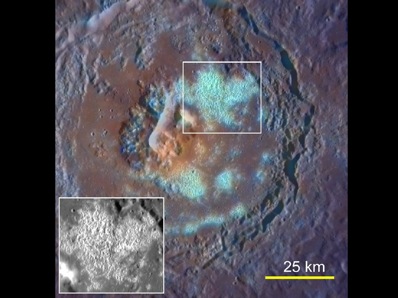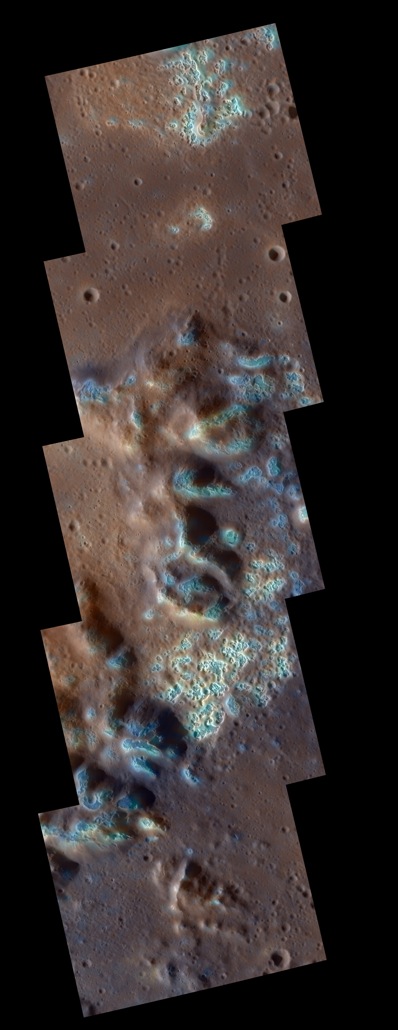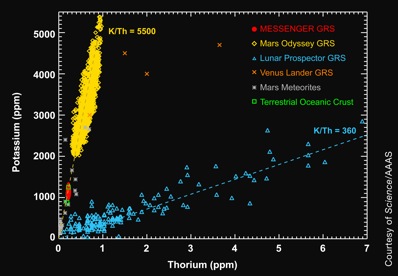



|

|

Myriad marvels on mysterious Mercury
KEITH COOPER
ASTRONOMY NOW
Posted: 29 September 2011


Mercury’s surprising surface composition is challenging theories of how the intriguing innermost planet formed, thanks to observations in orbit by NASA’s MESSENGER spacecraft, which also found evidence for copious ancient volcanism.
MESSENGER, the MErcury Surface, Space Environment, GEochemistry and Ranging spacecraft, has been orbiting Mercury since March, having made three previous fly-bys. “In orbit is definitely the place to be,” says James Head of Brown University. This allows the probe’s instruments to make unprecedented high-resolution images of the surface of the planet, and the results show that Mercury is far from being the dull grey world it at first appears.

Mercury’s 97-kilometre wide crater Tyagaraja with numerous hollows across its floor. Image courtesy: Science/AAAS.
Measurements made with MESSENGER’s Gamma-ray Spectrometer have shown that Mercury has a higher abundance of so-called volatile materials than expected. Volatiles are materials that can evaporate, and on rocky Mercury they include potassium and sulphur, which become detectable when they undergo radioactive decay, creating a characteristic gamma-ray signature. By comparing the relative abundance of potassium with thorium – a non volatile material – scientists can get a measure of the overall volatile abundance on the planet. In one of several papers based on MESSENGER results published in the journal Science today, the MESSENGER science team show that the ratio of volatiles to non-volatiles on Mercury is roughly the same as Venus, Earth and Mars and ten times greater than the Moon. This is surprising because Mercury’s proximity to the Sun, which sees surface temperatures climbing to 430 degrees Celsius, should have boild Mercury’s volatiles away long ago.
Mercury’s over-sized iron core had led to theories of its formation that attempt to explain this; for instance, a collision with another protoplanet early in its life could have stripped away much of Mercury’s mantle, leaving a depleted world relative to its core. However, these models fail to predict the amount of volatiles found on the surface. Only one model fits the data, says Patrick Peplowski of Johns Hopkins University Applied Physics Laboratory. “Mercury formed from chondritic material, in particular a type of partially melted metal-rich chondrites,” he says. Chondrites are material left over from the birth of the Solar System, and regularly fall to Earth as meteorites.

A multi-pane view of the floor of the Raditladi impact basin, with hollows around the central peak mountains. Image: NASA/JHUAPL/Carnegie Institution of Washington.
The presence of volatiles may also explain unusual pits, or ‘hollows’ found on bright crater rims. “There are no craters like this on the Moon,” says David Blewett, also of Johns Hopkins University. “They were an utter surprise to the science team.”
The hollows are found in craters large and small all across the planet and appear relatively young, raising the tantalising possibility that these hollows are still forming today and could be observed by MESSENGER. The hollows, says Blewett, are similar to the ‘Swiss cheese’ terrain found in the polar regions of Mars, where carbon dioxide ice sublimates, causing the surface to collapse into pits. Blewett suspects a similar process occurs on Mercury, where volatiles such as potassium evaporate under the Sun’s heat, leading to the surface becoming unstable and collapsing.

The abundance of the volatile potassium and the non-volatile thorium on the surface of Mercury, as measured by MESSENGER’s Gamma-Ray Spectrometer. Measurements of Mars, Venus and Earth are shown for comparison. Image courtesy of Science/AAAS.
The surface also sports vast floodplains of lava that dwarf the dark maria on the Moon. “The data collected in a mere few months has completely changed what we thought we knew about volcanism on Mercury,” says Head. The lava plains are up to two kilometres thick, but there is no evidence for any point sources of volcanism, such as the calderas of shield volcanos. Instead, the lava appears to have seeped up from long, linear vents that were subsequently mostly smothered by the lava, but a few have remained uncovered. MESSENGER found several of these vents, 25 kilometres long. Despite being an utterly desolate world compared to Earth, these volcanoes could tell us about our own planet’s past. “Such lavas may have been typical of an early period in Earth’s history, one for which only spotty evidence remains today,” says Head.
Mercury is turning into a dynamic world of large variability under the attentive gaze of MESSENGER. “These revelations emphasise that Mercury is a fascinating world that is unmatched in the Solar System,” says Blewett. "We have barely begun to understand what Mercury is really like and are eager to discover what it can tell us about the processes that led to formation of the planets as we see them today.”
|

|

|

|
|



